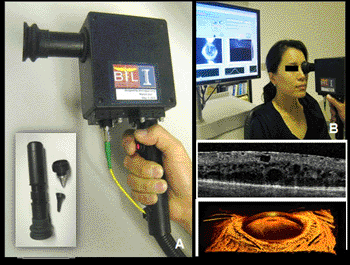Handheld Optical Coherence Tomography Imaging Device Developed for Primary Care Physicians
By MedImaging International staff writers
Posted on 08 Oct 2012
A new handheld scanner for primary care physicians would enable them to image all the areas they typically study, such as bacterial colonies in the middle ear in three-dimensional (3D), or monitor the thickness and health of patients’ retinas, and more. Posted on 08 Oct 2012
Surgeons in the operating room can visualize inside the human body in real time using sophisticated imaging technology, but primary care physicians have not typically had access to the same technology--until now. The device relies on optical coherence tomography (OCT), a visualization technology that is similar to ultrasound imaging, but uses light instead of sound to generate the images.

Image: An early prototype of the handheld scanner has both OCT and video imaging capabilities and interchangeable tips for the eyes, ears, skin and oral tissue. As one example, the device images the retina and the anterior eye structures (bottom right) (Photo courtesy of the University of Illinois).
The engineers, from the University of Illinois at Urbana-Champaign (UIUC; USA), will present their findings at the Optical Society’s (OSA) annual meeting, Frontiers in Optics (FiO) 2012, taking place October 14-18, 2012, in Rochester, NY, USA.
To monitor chronic disorders such as ear infections, primary care physicians currently utilize instruments that are in essence magnifying glasses, according to UIUC physician and biomedical engineer Dr. Stephen Boppart, who will present the team’s findings at FiO. The new handheld imaging device would provide physicians with a way to quantitatively monitor these conditions, and possibly make more effective referrals to specialists.
The scanners include three basic parts: a near-infrared light source and OCT system, a video camera to relay real-time images of surface features and scan locations, and a microelectromechanical (MEMS)-based scanner to direct the light. Near-infrared wavelengths of light penetrate deeper into human tissues than other wavelengths more readily absorbed by the body. By gauging the time it takes the light to rebound back from tissue microstructure, computer algorithms construct an image of the structure of tissue under examination.
Diabetic patients should also benefit from the device. Approximately 40%-45% of diabetics develop retinopathy, which can lead to thickening of the retina, blurry vision, and eventually blindness. The handheld OCT device would allow doctors to monitor the health of the retina, potentially identifying retinopathy in its early stages. In some instances, changes in the eye could help clinicians diagnose diabetes, Dr. Boppart reported.
Dr. Boppart and his team are hopeful that decreased production costs combined with smaller, more compact designs will enable more physicians to take advantage of the scanners, and become a common point-of-care tool. Ultimately, they would like to see the imagers at work in developing countries as well. He and an international team of collaborators recently received a USD 5 million National Institutes of Health Bioengineering Research Partnership grant to further refine the device.
Related Links:
University of Illinois at Urbana-Champaign














